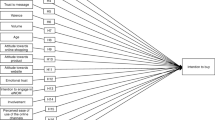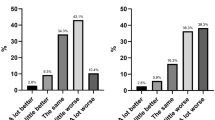Abstract
To select promising health messages, formative research has often relied on perceived message effectiveness (PME) scales assessing either of two related constructs, message perceptions (persuasive potential) and effects perceptions (potential for behavioral impact). We sought to examine their incremental criterion validity within a comparative framework. Participants were 703 U.S. adult smokers (ages \(\ge\) 21) who received anti-smoking or comparable control (littering) messages on their cigarette packs for 3 weeks. Structural equation models examined both PME constructs as simultaneous correlates of outcomes from the UNC Tobacco Warnings Model. Message perceptions demonstrated incremental criterion validity with attention, an early behavioral antecedent (\(\beta\) = 0.82, p < .001). Effects perceptions demonstrated incremental criterion validity with later behavioral antecedents (range \(\beta\) = 0.74–0.87, all p < .01) and quitting behaviors (\(\beta\) = 0.36–0.66, all p < .001). Formative research on anti-smoking messages may benefit from focusing on effects perceptions to characterize potential for behavior change.


Similar content being viewed by others
References
Baig, S. A., et al. (2018). UNC Perceived Message Effectiveness: Validation of a brief scale. Annals of Behavioral Medicine. https://doi.org/10.1093/abm/kay080
Bollen, K. A., Harden, J. J., Ray, S., & Zavisca, J. (2014). BIC and alternative Bayesian information criteria in the selection of structural equation models. Structural Equation Modeling: A Multidisciplinary Journal, 21(1), 1–19. https://doi.org/10.1080/10705511.2014.856691
Bollen, K. A., Ray, S., Zavisca, J., & Harden, J. J. (2012). A comparison of Bayes factor approximation methods including two new methods. Sociological Methods & Research, 41(2), 294–324. https://doi.org/10.1177/0049124112452393
Brennan, E., et al. (2013). Assessing the effectiveness of antismoking television advertisements: Do audience ratings of perceived effectiveness predict changes in quitting intentions and smoking behaviours? Tobacco Control, 23(5), 412–418. https://doi.org/10.1136/tobaccocontrol-2012-050949
Brewer, N. T., et al. (2018). Cigarette pack messages about toxic chemicals: A randomised clinical trial. Tobacco Control. https://doi.org/10.1136/tobaccocontrol-2017-054112
CDC. (2008). Cigarette smoking among adults—United States, 2007. MMWR. Morbidity and Mortality Weekly Report, 57(45), 1221–1226.
Chalmers, R. P. (2015). Extended mixed-effects item response models with the MH-RM algorithm. Journal of Educational Measurement, 52(2), 200–222. https://doi.org/10.1111/jedm.12072
Core Team, R. (2000). R language definition. Vienna, Austria: R Foundation for Statistical Computing.
Davis, S., et al. (2009). State-specific prevalence and trends in adult cigarette smoking-United States, 1998–2007. Morbidity and Mortality Weekly Report, 58(9), 221–226.
Davis, K. C., et al. (2011). Exploring African American women’s perceptions of a social marketing campaign to promote HIV testing. Social Marketing Quarterly, 17(3), 39–60. https://doi.org/10.1080/15245004.2011.595536
Davis, K. C., et al. (2013). Perceived effectiveness of cessation advertisements: The importance of audience reactions and practical implications for media campaign planning. Health Communication, 28(5), 461–472. https://doi.org/10.1080/10410236.2012.696535
Davis, K. C., et al. (2016). Perceived effectiveness of antismoking ads and association with quit attempts among smokers: Evidence from the TIPS From Former Smokers campaign. Health Communication, 32(8), 931–938. https://doi.org/10.1080/10410236.2016.1196413
Dillard, J. P., & Ha, Y. (2016). Interpreting perceived effectiveness: Understanding and addressing the problem of mean validity. Journal of Health Communication, 21(9), 1016–1022. https://doi.org/10.1080/10810730.2016.1204379
Dillard, J. P., Shen, L., & Vail, R. G. (2007a). Does perceived message effectiveness cause persuasion or vice versa? 17 consistent answers. Human Communication Research, 33(4), 467–488. https://doi.org/10.1111/j.1468-2958.2007.00308.x
Dillard, J. P., Weber, K. M., & Vail, R. G. (2007b). The relationship between the perceived and actual effectiveness of persuasive messages: A meta-analysis with implications for formative campaign research. Journal of Communication, 57(4), 613–631. https://doi.org/10.1111/j.1460-2466.2007.00360.x
Dillard, J. P., & Ye, S. (2008). The perceived effectiveness of persuasive messages: Questions of structure, referent, and bias. Journal of Health Communication, 13(2), 149–168. https://doi.org/10.1080/10810730701854060
Donovan, R. J., Jalleh, G., & Carter, O. B. J. (2006). Tobacco industry smoking prevention advertisements’ impact on youth motivation for smoking in the future. Social Marketing Quarterly, 12(2), 3–13. https://doi.org/10.1080/15245000600721644
Fathelrahman, A. I., Omar, M., Awang, R., et al. (2010). Impact of the new Malaysian cigarette pack warnings on smokers’ awareness of health risks and interest in quitting smoking. International Journal of Environmental Research and Public Health, 7(11), 4089–4099. https://doi.org/10.3390/ijerph7114089
Fishbein, M., & Ajzen, I. (2010). Predicting and changing behavior: The reasoned action approach. New York, NY: Psychology Press.
Hall, M. G., et al. (2018). Why smokers avoid cigarette pack risk messages: Two randomized clinical trials. Social Science & Medicine, 213, 165–172.
Hyland, A., et al. (2016). Design and methods of the Population Assessment of Tobacco and Health (PATH) study. Tobacco Control, 26(4), 371–378. https://doi.org/10.1136/tobaccocontrol-2016-052934
Jarosz, A. F., & Wiley, J. (2014). What are the odds? A practical guide to computing and reporting Bayes factors. Journal of Problem Solving. https://doi.org/10.7771/1932-6246.1167
Keller, P. A., & Block, L. G. (1996). Increasing the persuasiveness of fear appeals: The effect of arousal and elaboration. Journal of Consumer Research, 22(4), 448. https://doi.org/10.1086/209461
Klein, W. M. P., Zajac, L. E., & Monin, M. M. (2009). Worry as a moderator of the association between risk perceptions and quitting intentions in young adult and adult smokers. Annals of Behavioral Medicine, 38(3), 256–261. https://doi.org/10.1007/s12160-009-9143-2
Lambert, S. D., & Loiselle, C. G. (2007). Health information-seeking behavior. Qualitative Health Research, 17(8), 1006–1019. https://doi.org/10.1177/1049732307305199
Lee, S., et al. (2011). Smoking cues, argument strength, and perceived effectiveness of antismoking PSAs. Nicotine & Tobacco Research, 13(4), 282–290. https://doi.org/10.1093/ntr/ntq255
Li, L., et al. (2014). Smoking-related thoughts and microbehaviours, and their predictive power for quitting. Tobacco Control, 24(4), 354–361. https://doi.org/10.1136/tobaccocontrol-2013-051384
Millsap, R. E., & Yun-Tein, J. (2004). Assessing factorial invariance in ordered-categorical measures. Multivariate Behavioral Research, 39(3), 479–515. https://doi.org/10.1207/s15327906mbr3903_4
Nelson, D., et al. (2004). The Health Information National Trends Survey (HINTS): Development, design, and dissemination. Journal of Health Communication, 9(5), 443–460. https://doi.org/10.1080/10810730490504233
Niederdeppe, J., et al. (2011). Socioeconomic variation in recall and perceived effectiveness of campaign advertisements to promote smoking cessation. Social Science and Medicine, 72(5), 773–780. https://doi.org/10.1016/j.socscimed.2010.12.025
Noar, S. M. (2006). A 10-year retrospective of research in health mass media campaigns: Where do we go from here? Journal of Health Communication, 11(1), 21–42. https://doi.org/10.1080/10810730500461059
Noar, S. M., et al. (2016). Pictorial cigarette pack warnings: A meta-analysis of experimental studies. Tobacco Control, 25(3), 341–354. https://doi.org/10.1136/tobaccocontrol-2014-051978
Noar, S. M., Barker, J., & Yzer, M. (2018a). Measurement and design heterogeneity in perceived message effectiveness studies: A call for research. Journal of Communication, 68(5), 990–993. https://doi.org/10.1093/joc/jqy047
Noar, S. M., et al. (2018b). Perceived message effectiveness measures in tobacco education campaigns: A systematic review. Communication Methods and Measures, 12(4), 295–313. https://doi.org/10.1080/19312458.2018.1483017
Noar, S. M., et al. (2018c). Identifying principles for effective messages about chemicals in cigarette smoke. Preventive Medicine, 106, 31–37. https://doi.org/10.1016/j.ypmed.2017.09.005
Nonnemaker, J., et al. (2010). Experimental study of graphic cigarette warning labels. Final Results Report. RTI Project, 7
O’Keefe, D. J. (2018). Message pretesting using assessments of expected or perceived persuasiveness: Evidence about diagnosticity of relative actual persuasiveness. Journal of Communication, 68(1), 120–142. https://doi.org/10.1093/joc/jqx009
Partos, T. R., et al. (2014). The predictive utility of micro indicators of concern about smoking: Findings from the International Tobacco Control Four Country Study. Addictive Behaviors, 39(8), 1235–1242. https://doi.org/10.1016/j.addbeh.2014.04.001
Revelle, W. (2011). An overview of the psych package. Department of Psychology Northwestern University. Retrieved 3 March, 2012.
Rosseel, Y. (2012). Lavaan: An R package for structural equation modeling. Journal of Statistical Software, 1, 2. https://doi.org/10.18637/jss.v048.i02
Vispoel, W. P., Morris, C. A., & Kilinc, M. (2017). Practical applications of generalizability theory for designing, evaluating, and improving psychological assessments. Journal of Personality Assessment. https://doi.org/10.1080/00223891.2017.1296455
Watson, D., Clark, L. A., & Tellegen, A. (1988). Development and validation of brief measures of positive and negative affect: The PANAS scales. Journal of Personality and Social Psychology, 54(6), 1063–1070. https://doi.org/10.1037/0022-3514.54.6.1063
Wickham, H. (2016). Ggplot2: Elegant graphics for data analysis. Berlin: Springer. https://doi.org/10.1007/978-3-319-24277-4
Yzer, M., LoRusso, S., & Nagler, R. H. (2014). On the conceptual ambiguity surrounding perceived message effectiveness. Health Communication, 30(2), 125–134. https://doi.org/10.1080/10410236.2014.974131
Acknowledgements
Research reported in this publication was supported by Grant Number P50CA180907 from the National Cancer Institute and FDA Center for Tobacco Products. Research reported in this publication was also partially supported by the National Institute on Drug Abuse through grant funding awarded to Dr. Gottfredson (K01DA0351523). The content is solely the responsibility of the authors and does not necessarily represent the official views of the National Institutes of Health or the Food and Drug Administration.
Author information
Authors and Affiliations
Corresponding author
Ethics declarations
Conflict of interest
None of the authors have received funding from tobacco product manufacturers. Dr. Brewer has served as a paid consultant in litigation against tobacco companies. Dr. Ribisl has served as an expert consultant in litigation against cigarette manufacturers and Internet tobacco vendors. Dr. Ribisl is also a member of the Tobacco Products Scientific Advisory Committee for the FDA Center for Tobacco Products. The views expressed in this paper are his and not those of the FDA. The authors declare no conflict of interest.
Human and animal rights and Informed consent
All procedures followed were in accordance with ethical standards of the responsible committee on human experimentation (institutional and national) and with the Helsinki Declaration of 1975, as revised in 2000. Informed consent was obtained from all individual participants included in the study.
Additional information
Publisher's Note
Springer Nature remains neutral with regard to jurisdictional claims in published maps and institutional affiliations.
Electronic supplementary material
Below is the link to the electronic supplementary material.
Rights and permissions
About this article
Cite this article
Baig, S.A., Noar, S.M., Gottfredson, N.C. et al. Incremental criterion validity of message perceptions and effects perceptions in the context of anti-smoking messages. J Behav Med 44, 74–83 (2021). https://doi.org/10.1007/s10865-020-00163-0
Received:
Accepted:
Published:
Issue Date:
DOI: https://doi.org/10.1007/s10865-020-00163-0




